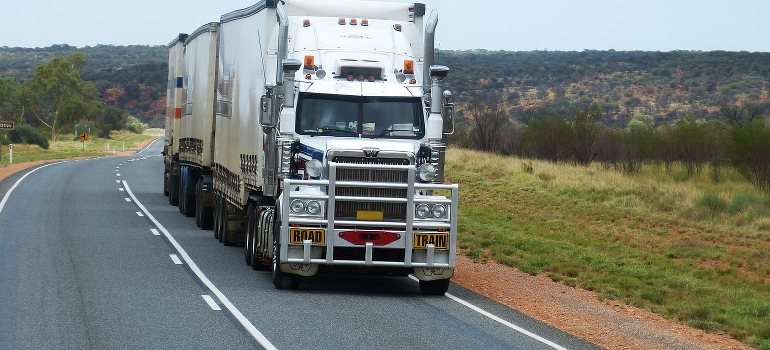Calculating Your Move’s Carbon Footprint
Did you know that every box you pack, every mile you travel, and every piece of furniture you transport contributes to your move’s carbon footprint? As environmental awareness grows, more people are looking to understand and mitigate the ecological consequences of their actions, including relocation. Calculating your move’s carbon footprint may seem confusing at the start, however, breaking down the various elements that contribute to carbon emissions during a move helps you make informed decisions. So, allow the best movers Seattle has to show you how to move responsibly and make more sustainable choices, leaving a smaller carbon footprint in your wake.
Transportation: The Major Contributor to Your Move’s Carbon Footprint
When it comes to moving, transportation is the heavyweight champion of carbon emissions. As you explore this topic, it’ll become clear that the journey from your old home to your new one plays a crucial role in determining your move’s environmental impact. Here’s what you need to know to make informed and eco-friendly transportation choices.
Distance: The Emission Multiplier
One of the most straightforward yet significant factors influencing transportation emissions is the distance you travel. It’s simple math: the farther you move, the more fuel you’ll burn, and the more CO2 you’ll release into the atmosphere. A move with local movers in Seattle, within the same city will naturally have a much lower carbon footprint than a U.S. cross-country or international relocation.

Mode of Transport: Different Wheels, Different Footprints
Not all vehicles are created equal when it comes to emissions. Moving trucks, vans, personal cars, and airplanes each have distinct fuel efficiencies and emissions profiles.
- Moving Trucks and Vans: These are the go-to choices for most moves. However, their size and weight mean they consume more fuel and emit more CO2. The Environmental Protection Agency (EPA) estimates that an average moving truck emits about 10 to 20 pounds of CO2 per mile.
- Personal Cars: If you’re making multiple trips in personal cars, the emissions can add up quickly. Although smaller than moving trucks, cars are often less efficient when fully loaded.
- Air Freight: For long-distance or international moves, air freight might seem convenient, but it comes with a hefty environmental price tag. Airplanes emit a significant amount of CO2, making air freight the least eco-friendly option.
Fuel Type: A Key Emission Factor
The type of fuel your vehicle uses can dramatically affect your carbon footprint.
- Gasoline vs. Diesel: Diesel engines tend to be more fuel-efficient than gasoline engines, but they also produce higher levels of certain pollutants, including nitrogen oxides and particulate matter. On the other hand, gasoline engines produce more CO2 per gallon of fuel burned.
- Electric Vehicles (EVs): If you have access to an electric moving truck or van, this can significantly reduce your carbon footprint, especially if the electricity comes from renewable sources. EVs produce zero tailpipe emissions, making them the greenest option available.
It should be noted that EVs’ overall carbon footprint depends on the source of electricity used to charge them. If the electricity comes from fossil fuels, such as coal or natural gas, the emissions from power plants can still be significant. However, even with fossil-fuel-derived electricity, EVs often have a lower overall carbon footprint compared to traditional gasoline or diesel vehicles due to their higher energy efficiency.
Practical Tips for Reducing Transportation Emissions
Here are some practical steps you can take to minimize the transportation-related carbon footprint of your move:
- Consolidate Trips: Combine as many items as possible into a single trip. This reduces the number of miles driven and the overall fuel consumption.
- Optimize Route Planning: Plan the most efficient route to avoid unnecessary miles. Use GPS and mapping tools to find the shortest and least congested paths.
- Choose Fuel-Efficient Vehicles: If you have the option, select a moving truck or van with better fuel efficiency. Some moving companies offer eco-friendly vehicles that run on biodiesel or are hybrid models.
- Consider Rail Transport: For long-distance moves, rail transport is a more environmentally friendly option compared to trucks or air freight. It can significantly reduce CO2 emissions per mile traveled.
- Offset Your Emissions: Look into carbon offset programs where you can compensate for your emissions by investing in environmental projects such as reforestation or renewable energy initiatives.
Understanding the transportation aspect of your move’s carbon footprint is crucial in making eco-friendly choices. And, with careful planning and informed decisions, you can ensure that your transition to a new home leaves a smaller carbon footprint, contributing to a healthier planet.
Volume and Weight of Belongings: Less is More for the Planet
The more you move, the more fuel you consume. Hence, it becomes evident that the volume and weight of your belongings are significant factors in calculating your move’s carbon footprint.
Decluttering is not just about making your move easier; it’s also an effective way to lower your carbon footprint. Therefore, by getting rid of items you no longer need, you reduce the volume and weight of what you need to transport, consequently reducing the energy use for your move. Decluttering directly decreases the number of trips required and the size of the vehicle needed, leading both to lower fuel consumption and emissions.
Also, consider donating usable items to charities or selling them online. It not only helps others but also extends the life of your possessions, reducing waste and the demand for new products. Moreover, properly recycling items ensures they are repurposed and don’t end up in landfills, which can generate methane, a potent greenhouse gas.

Packing efficiently is another crucial aspect of reducing your move’s carbon footprint. Pack items tightly and use all available space in boxes and vehicles. Efficient packing reduces the number of trips and the size of the vehicle you require, cutting down on fuel use and emissions.
Use containers that can be reused for storage in your new home. This minimizes waste and the need for single-use packing materials. Additionally, break down large furniture and items where possible to save space and allow for more compact packing.
Packing Materials: Choosing Sustainable Options
Packing materials play a significant role in the environmental impact of your move. Traditional materials like cardboard, plastic wrap, and foam can contribute to pollution and waste. Here’s a closer look at how you can make more sustainable choices.
Cardboard Boxes: Recycled and Reusable Options
Cardboard boxes are a moving staple, but they come with an environmental cost:
- Use Recycled Boxes: Opt for boxes made from recycled materials. Producing recycled cardboard uses less energy and water compared to new cardboard, reducing emissions.
- Reuse Boxes: Reusing boxes you already have or obtaining used boxes from local stores or online marketplaces reduces the demand for new boxes and the associated environmental impact.
- Recyclable Alternatives: After your move, ensure that any cardboard boxes are properly recycled to minimize waste.
Plastic Wrap and Bubble Wrap: Biodegradable and Reusable Alternatives
Plastic wrap and bubble wrap are convenient but problematic for the environment:
- Biodegradable Options: Look for biodegradable packing materials. These break down more easily in the environment, reducing long-term pollution.
- Reusable Wraps: Consider using reusable moving blankets, towels, or clothing to wrap fragile items. These alternatives not only protect your belongings but also cut down on single-use plastics.
Packing Peanuts and Foam: Eco-Friendly Choices
Traditional packing peanuts and foam can be particularly harmful to the environment:
- Biodegradable Packing Peanuts: Made from natural, non-toxic materials like cornstarch, these peanuts dissolve in water and are compostable, making them a much greener option.
- Recycled Paper: Shredded recycled paper can be used as a cushioning material. It’s biodegradable and can be recycled again after use.
- Eco-Friendly Foam Alternatives: Some companies offer foam made from biodegradable materials that provide the same protection as traditional foam but with a lower environmental impact.
Understanding the impact of the volume and weight of your belongings and the packing materials you use is essential in calculating your move’s carbon footprint—and reducing it. As you engage in decluttering, packing efficiently, and choosing sustainable packing materials, you significantly lower the environmental impact of your relocation!

Moving Services: Influencing the Carbon Footprint
If you hire professional Washington movers, their practices can significantly influence the carbon footprint of your move. Whether you choose a company that prioritizes sustainability or is striving to improve, here’s how their operations can impact your move’s environmental footprint.
Green Moving Companies
Some moving companies offer eco-friendly services designed to reduce their environmental impact. Such companies often use biodiesel trucks, emitting less carbon dioxide than traditional diesel or gasoline vehicles.
They may also provide reusable packing materials, such as sturdy plastic crates instead of single-use cardboard boxes, and offer options for recycling unwanted items. Hence, if you choose a green moving company, you significantly reduce the carbon emissions associated with your move and support businesses committed to sustainability.
Efficiency of Operations
The overall efficiency of a moving company’s operations can also affect emissions. Efficient route planning ensures that movers take the shortest and most fuel-efficient paths, minimizing unnecessary mileage and fuel consumption. Loading efficiency is another critical factor; well-organized packing means fewer trips are required, reducing the total distance traveled and fuel used.
Additionally, companies that optimize their schedules and resource allocation while providing moving services in Seattle can lower their overall carbon footprint. Even if a moving company is not explicitly green, striving for operational efficiency can substantially reduce emissions.
Disposal of Unwanted Items: Minimizing Your Carbon Footprint
How you dispose of items you don’t move plays a crucial role in determining and calculating your move’s carbon footprint. Here’s how properly managing these items can significantly reduce your environmental impact.
Recycling Before the Move
Correctly recycling materials reduces emissions compared to sending items to landfills. When you recycle, materials like paper, plastic, and metal are processed and reused, which consumes less energy than producing new materials from scratch. This not only reduces greenhouse gas emissions but also helps conserve natural resources. Make sure to sort your recyclables according to your local recycling guidelines and take them to a proper recycling facility.

Donations and Sales
Donating or selling items extends their life and reduces waste. When giving your usable items to charities or selling them online, you prevent them from ending up in landfills and provide valuable resources to others. Many organizations accept a wide range of items, from clothing and furniture to electronics and books. Hosting a garage sale or using online platforms like eBay, Craigslist, or Facebook Marketplace can also help you find new homes for your belongings.
Disposal of Hazardous Household Items
Items such as batteries, paint, chemicals, and electronic waste (e-waste) contain substances that can be harmful if not disposed of correctly. Hence, proper disposal of hazardous household items is essential for minimizing environmental harm. Many communities have special collection programs or drop-off locations for hazardous waste. Participating in these programs ensures that these materials are handled safely and recycled or disposed of in an environmentally responsible manner.
Setting Up Your New Home: A Sustainable Start
As you settle into your new home, continuing your commitment to sustainability is crucial. Here are some key considerations for a green setup:
- Energy Efficiency: Choose ENERGY STAR appliances, replace incandescent bulbs with LED or CFL bulbs, and ensure proper insulation.
- Renewable Energy: Consider installing solar panels or other renewable energy systems, taking advantage of available incentives.
- Water Conservation: Install low-flow showerheads, faucets, and toilets, and consider rainwater harvesting for irrigation.
- Eco-friendly Cleaning: Green cleaning practices with products made from natural, biodegradable ingredients reduce indoor air pollution.
- Sustainable Furnishings: Select furniture made from reclaimed or sustainably sourced wood, opt for second-hand items, and choose textiles from organic or recycled materials.
Moving to a new home provides an opportunity to embrace sustainable living. After calculating your move’s carbon footprint and making eco-friendly choices in setting up your new space, you contribute to a healthier environment and a more conscious lifestyle. Every small step counts towards preserving our planet for future generations!
Why Choose Us
History
Hansen Bros. Moving & Storage is locally owned and operated by the same family for four generations, since 1890. We have a well-established reputation for service quality and reliability with a high percentage of repeat household and commercial clients.
Professionalism
We’re a certified ProMover by the American Moving and Storage Association with A+ rating with the Better Business Bureau, voted “Best in Western Washington” in 2009 and from 2011 to 2016 by KING5. Our company is fully licensed and insured and member of WMC and AMSA.
Value
Hansen Bros. Moving & Storage provide free, no-obligation in-home estimate and competitive rates, including low minimum rates for shipments moving under 300 miles. We’ve set a refund policy for unused packing materials and three Puget Sound locations to help clients save on travel fee costs.



